Eastern Coral Snake
Micrurus fulvius
One of the most dangerous snakes in the USA.
Advertisement
Eastern Coral Snake Scientific Classification
- Kingdom
- Animalia
- Phylum
- Chordata
- Class
- Reptilia
- Order
- Squamata
- Family
- Elapidae
- Genus
- Micrurus
- Scientific Name
- Micrurus fulvius
Read our Complete Guide to Classification of Animals.
Eastern Coral Snake Conservation Status
Eastern Coral Snake Facts
View all of the Eastern Coral Snake images!
“The Eastern Coral Snake is described as ‘Beautiful and Dangerous”
Also called the harlequin coral snake, this slender, jewel-toned elapsid is one of the most beautiful in the United States, with its bands of red, yellow, and black. It’s also one of the most dangerous, as it produces a paralyzing neurotoxin. The good news is that it’s shy, likes to hide, and it takes a lot of provocation for it to bite a human. It is best to admire it from a bit of a distance. Read on for more information about this pretty reptile.
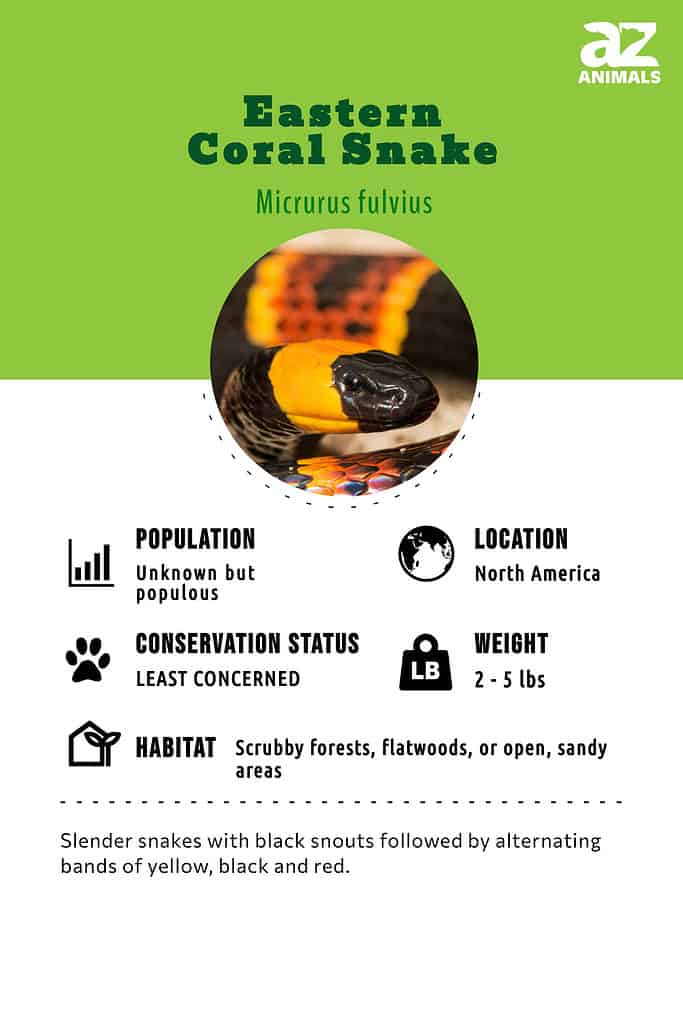
Four Amazing Facts About Coral Snakes
Here are four facts about the coral snake.
- The coral snake has a host of nonvenomous imitators. Among them are the scarlet kingsnake, the scarlet snake, and the red milk snake.
- It is not above eating other coral snakes.
- There are only about 100 coral snake bites every year in the United States, but they need to be taken very seriously.
- The coral snake’s fangs are small, but unlike many believe, they are not in the back of the mouth.
- They do not need to chew to envenomate their prey but hold on to keep it from escaping because they often eat other snakes.
Where To Find Eastern Coral Snakes
Eastern coral snakes are only found in the southeastern part of the United States. It prefers habitats that provide hammocks and flatwoods that feature slash pine and saw palmettos or somewhat arid, open, sandy locations that don’t have too much vegetation. It’s also found in scrubby forest habitats near the coasts of North and South Carolina.
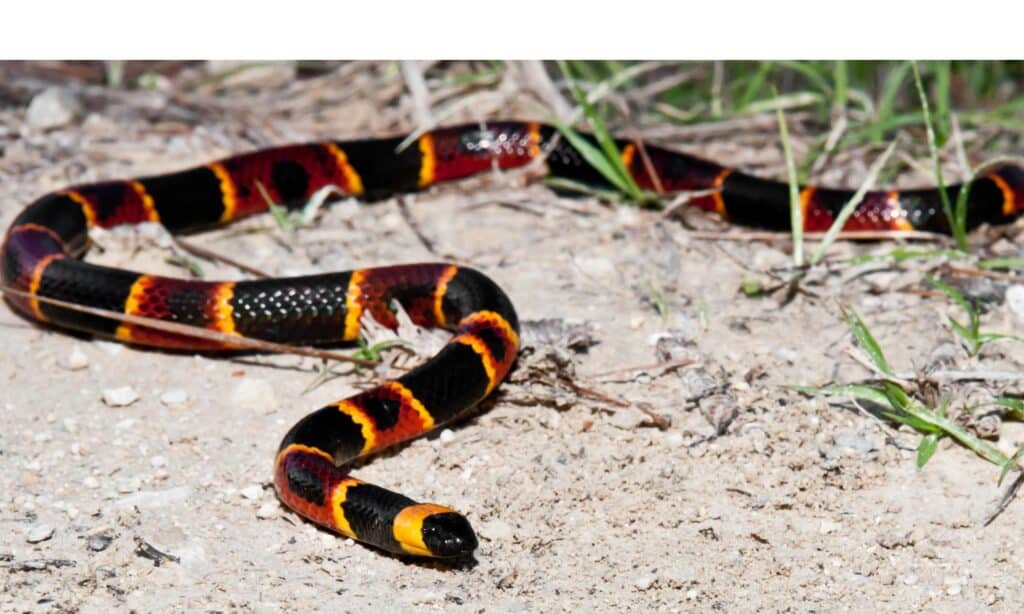
There is debate over the taxonomy of the eastern coral snake – but for now, there are no subspecies listed.
©iStock.com/JasonOndreicka
Scientific Name
The eastern coral snake’s scientific name is Micrurus fulvius. Micrurus comes from the Greek words for “small” which is mikros and “tail” which is oura. Fulvius is Latin for “orange-yellow,” which described a reptile whose bright red color had faded somewhat. Whether the eastern coral snake has subspecies and how many is a little controversial. The Integrated Taxonomic Information System, for example, does not list subspecies for this snake, while other places list:
- M.f. fitzingeri
- M.f. microgalbineus
- M.f. fulvius
- M.f. tenere
- M.f. barbouri
Other experts believe these snakes are either not valid subspecies or, as in the case of M.f. tenere, their own species.
The Different Types of Coral Snake
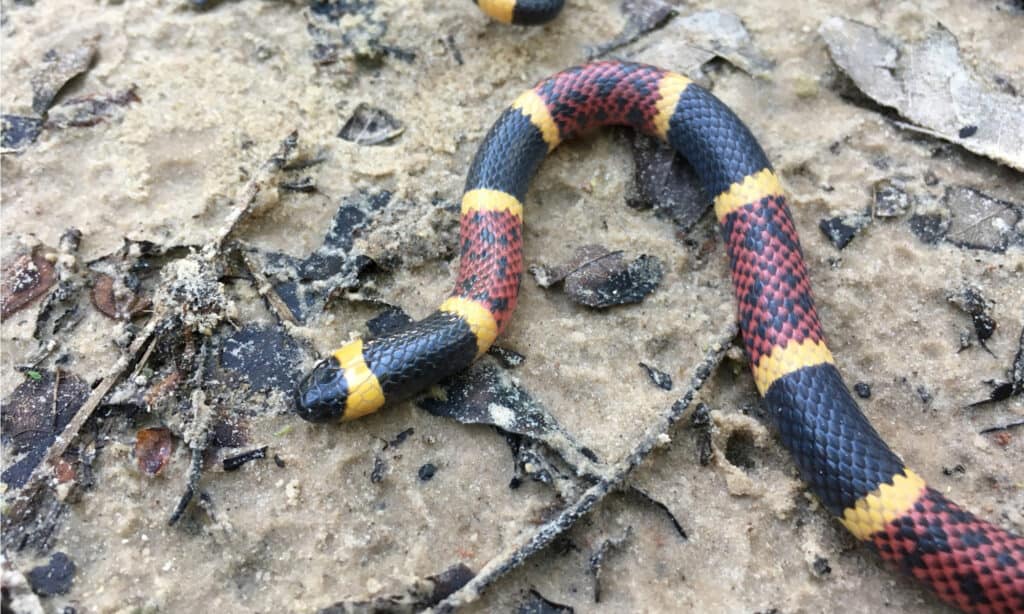
The Texas coral snake is longer than the eastern coral snake and has a larger venom yield.
©Joe Farah/Shutterstock.com
Even if there’s only one type of eastern coral snake, there are many species in the Micrurus genus. Micrurus tener, which is sometimes thought to be a subspecies of M. fulvius, is the Texas coral snake. Its range is from the southern United States down to Mexico. M. tener itself has five subspecies.
The Argentinian coral snake, M. pyrrhocryptus, lives in South America and is partial to the hot and dry habitat of the Dry Chaco, which is shared by northern Argentina, eastern Bolivia, some of Brazil, and western Paraguay.
The location of Bogert’s coral snake, M. bogerti is in southern Mexico. Its conservation status is data deficient, but it is protected by law. The Oaxacan coral snake, M. ephippifer has a range that extends from the tropical deciduous forests of coastal Oaxaca to the Isthmus of Tehuantepec. It has two subspecies, and its conservation status is vulnerable.
Evolution
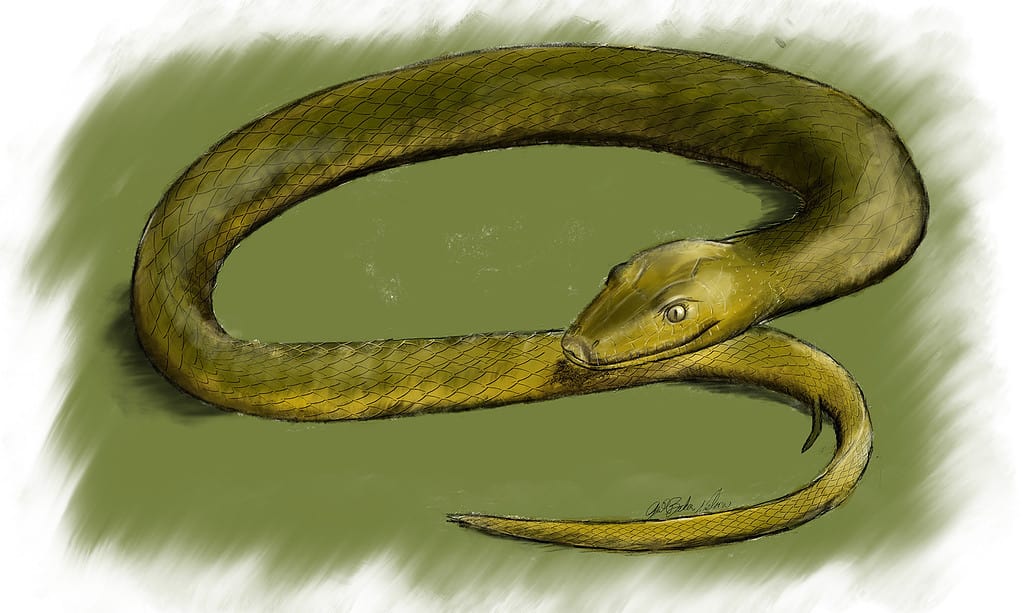
Fossil records show that snakes first appeared during the early Cretaceous period – although they often retained their hind limbs. The earliest true snake fossils come from the marine simoliophiids, the first being Hassiophis terasanctus, dated between 112 – 94 million years ago.
Scientists believe that snakes descended from lizards. Pythons and boas the most primitive snakes, have vestigial hind limbs and some have remnants of a pelvic girdle appearing as horny projections.
Many modern snakes originated during the Paleocene alongside the radiation of mammals that occurred after the extinction of non-avian dinosaurs. The expansion of grasslands in North America led to a major radiation of snakes. During the Miocene, the number of snake species increased with the first vipers and elapids and the diversification of Columbridae.
Appearance and Description
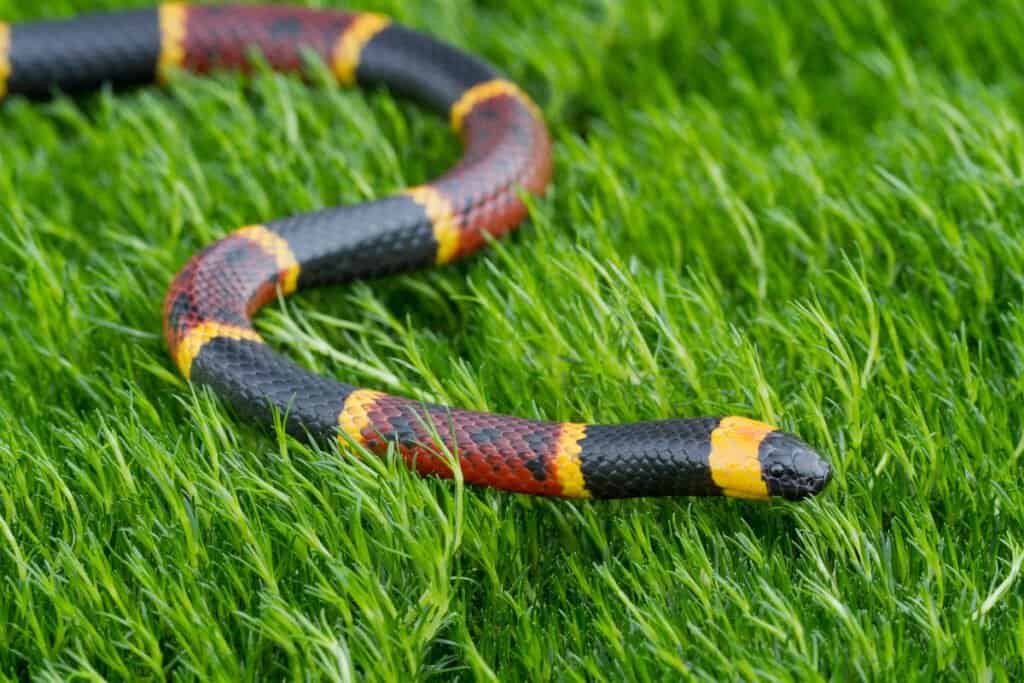
Eastern coral snakes are usually two to four feet long.
©Mark_Kostich/Shutterstock.com
Micrurus coral snakes such as the eastern coral snake are found in the New World, which is North, Central, and South America. They are graceful, slender snakes whose length ranges between 2 and 3 feet when they’re mature, though some have grown to over 4 feet.
In the U.S., the adage “red touch yellow, kill a fellow,” usually does apply to a coral snake unless they are some sort of mutation. However, the further south you go into Mexico and Central and South America, the adage is not reliable.
The eastern coral snake has a black snout followed by a band of yellow, then black, then yellow or white, then red, then yellow then black all the way down to the tail. It has 15 rows of smooth scales on its body and a divided anal plate. Females are longer than males. Unlike other venomous snakes such as rattlers, the fangs of the coral snake are small and do not fold back into its mouth when its mouth is closed.
Diet
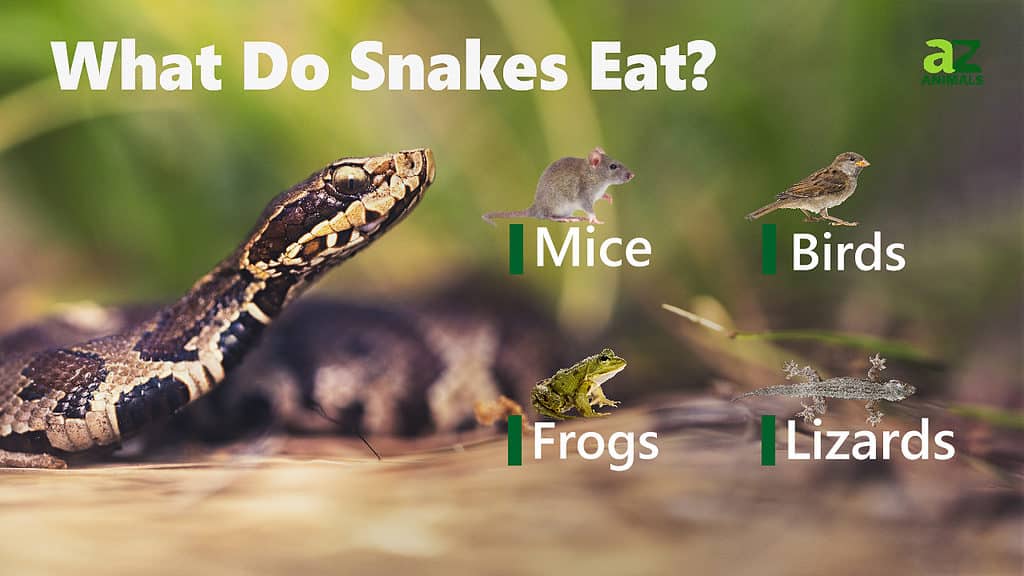
Unlike many other snakes, the eastern coral snake doesn’t seem to prefer small mammals such as rats or mice (although they will eat them) but is more likely to take frogs, fish, insects, birds, lizards, and even other snakes.
How Dangerous Are They?

©Jay Ondreicka/Shutterstock.com
The coral snake is one of a handful of truly dangerously venomous snakes that live in North America. Its venom is a neurotoxin, which means it attacks the nervous system. When the snake bites its prey the venom paralyzes and then kills them. Humans who get a lethal bite can die because their respiratory system is paralyzed. Yet, death from the bite of a coral snake is rare in the United States. The snake is fossorial, which means it burrows and is somewhat shy. Even when eastern coral snakes do bite, health professionals believe that as many as 60 percent of the bites are dry.
Behavior and Humans
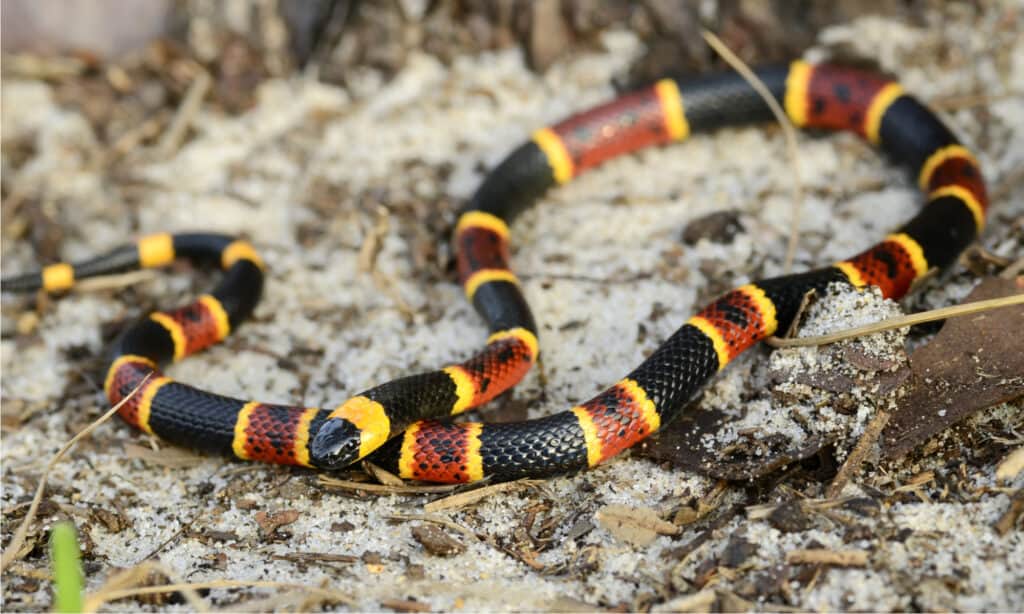
Eastern coral snakes pass gas with a loud pop to scare predators.
©Patrick K. Campbell/Shutterstock.com
Eastern coral snakes tend to be secretive, and many people are surprised when they find one living rather close to their home or even in their home. The coral snake is not aggressive toward humans. It’s not eager to bite to defend itself but will try to get away first. Since the tail and the head of a coral snake are about the same sizes, it wiggles its tail to make a predator think it’s the snake’s head. The snake also, it must be said, passes gas with a pop to startle a predator. It spends much of its time hiding under logs, leaf litter, or rotting stumps.
The coral snake is active during the day and is mostly active in spring and from late summer to fall. Spring is also the snake’s breeding season, and the female lays clutches of five to 12 eggs in May, June, and July. They hatch in about two months. Females are mature when they’re about 21 to 27 months old, and males are mature when they’re 11 to 21 months old. The snake is very thin and the length of a fully-grown coral snake ranges between 2 and 3 feet. It lives about seven years. Eastern coral snakes are not in danger of extinction, and their conservation status is the least concern.
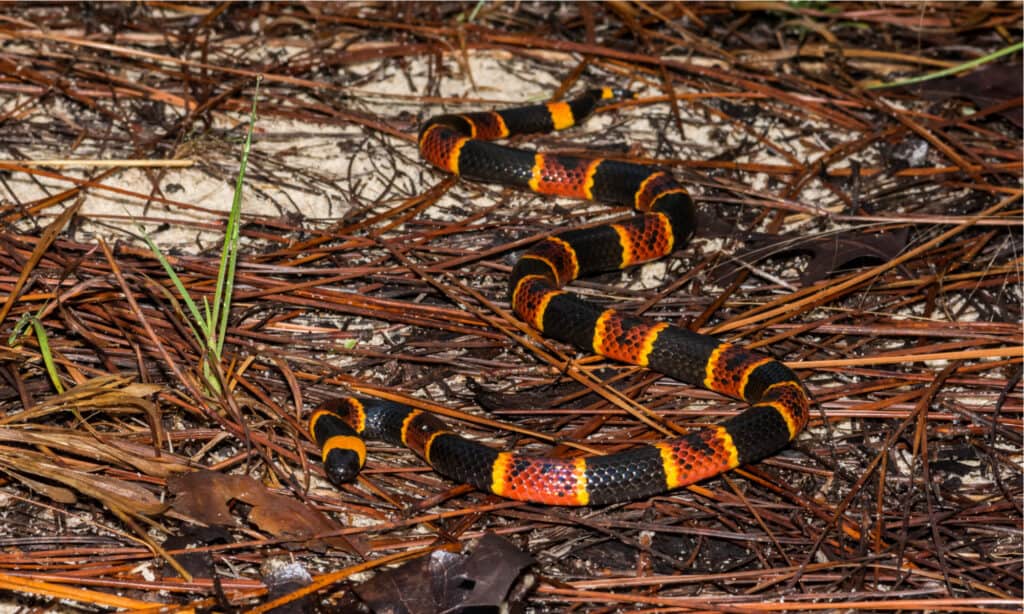
Female eastern coral snakes lay clutches of 5 – 12 eggs in May, June, and July.
©Jay Ondreicka/Shutterstock.com
Similar Animals
- Texas coral snakes used to be classified as subspecies of eastern coral snakes.
- Coral snakes are cousins to cobras and are in the same family.
- Milk snakes are sometimes mistaken for coral snakes, but aren’t venomous.
Eastern Coral Snake FAQs (Frequently Asked Questions)
Is the eastern coral snake venomous?
The eastern coral snake is extremely venomous. Though it is not a large snake and even its fangs aren’t very long, it contains enough venom to kill five adult humans.
What happens if an eastern coral snake bites you?
Even though the snake has probably administered a dry bite, you need medical care and antivenin right away. If you delay, you may experience double vision, slurred speech, and other signs that your nervous system is shutting down. Eventually, the nerves that control the muscles you breathe with will be paralyzed, and you will suffer respiratory failure and possibly die.
Is an eastern coral snake a good pet?
The eastern coral snake wouldn’t make a good pet simply because it is so venomous.
Where is the eastern coral snake found?
The location of the eastern coral snake is as far north as southeastern North Carolina and ranges south through South Carolina, Georgia, the Florida peninsula, and west to the southeastern part of Louisiana. Some people believe that the eastern coral snake has subspecies that extend the range into Texas, southeast Arkansas, and western Louisiana.
How big are eastern coral snakes?
They usually grow between 2 and 3 feet and rarely reach 4 feet long and very thin.
Thank you for reading! Have some feedback for us? Contact the AZ Animals editorial team.
Sources
- ITIS / Accessed April 27, 2022
- Savannah River Ecology Laboratory / Accessed April 27, 2022
- Wikipedia / Accessed April 27, 2022
- Live Science / Accessed April 27, 2022
- Kidadl / Accessed April 27, 2022
- The Reptile Database / Accessed April 27, 2022
- Morgan, Ray;The Most Common Myths About Coral Snakes, the Venom Interviews / Accessed December 22, 2022


















